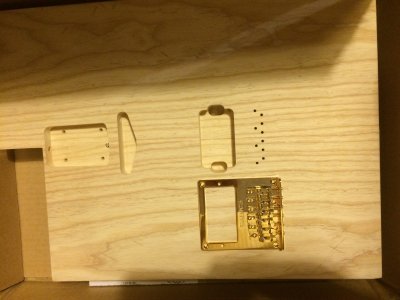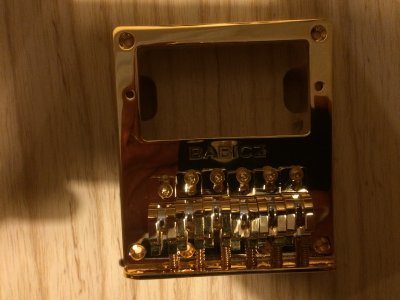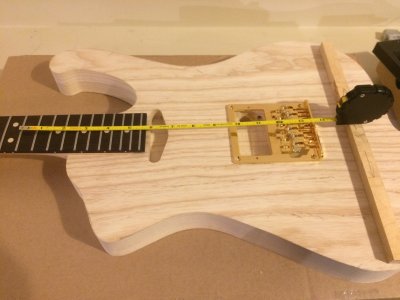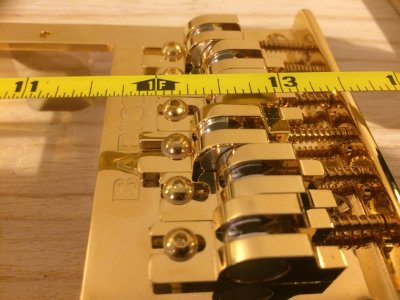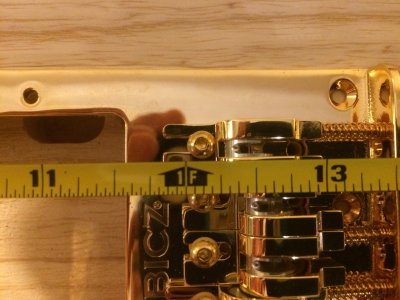
You are using an out of date browser. It may not display this or other websites correctly.
You should upgrade or use an alternative browser.
You should upgrade or use an alternative browser.
New Build Question
- Thread starter bobsessed
- Start date
Logrinn
Hero Member
- Messages
- 3,635
I'm no expert and haven't seen or worked with a Babicz IRL, but I guess that would be the way to do it.
As long as the saddles can move sufficiently so you can intonate it, then I guess it would be ok.
I'm sure you'll get more input from the experts here momentarily, like Cagey who knows everything.
As long as the saddles can move sufficiently so you can intonate it, then I guess it would be ok.
I'm sure you'll get more input from the experts here momentarily, like Cagey who knows everything.
Cagey
Mythical Status
- Messages
- 24,425
One would hope that would do it. But, you need to check that the saddles will end up in the right place to match your scale length.
The high E will end up closest (but not exactly) to your actual scale length once intonated. So, do this:
[list type=decimal]
[*]Attach your neck temporarily - just one or two screws so it stays in place.
[*]Measure the neck from the heel side of the nut to the 12th fret.
[*]Place the bridge so the string holes line up.
[*]Measure from the 12th fret to the breakover of the high E saddle.
[/list]
Distance (4) should be very close or within adjustment range of distance (2). If not, you're gonna have some work to do.
The high E will end up closest (but not exactly) to your actual scale length once intonated. So, do this:
[list type=decimal]
[*]Attach your neck temporarily - just one or two screws so it stays in place.
[*]Measure the neck from the heel side of the nut to the 12th fret.
[*]Place the bridge so the string holes line up.
[*]Measure from the 12th fret to the breakover of the high E saddle.
[/list]
Distance (4) should be very close or within adjustment range of distance (2). If not, you're gonna have some work to do.
Fat Pete
Hero Member
- Messages
- 1,657
Apologies if this stating the obvious, but the pickup rout needs to match too. If that's not in the right place when the string-through holes are, you are indeed in for some work.
I may be wrong (and I very often am) but it looks to me that you have the Billy Gibbons bridge when you want the Z series. Good luck.
I may be wrong (and I very often am) but it looks to me that you have the Billy Gibbons bridge when you want the Z series. Good luck.
stratamania
Mythical Status
- Messages
- 11,942
I was just about to post something similar to Fat Pete.
Looks like a BFG Bridge, and a Vintage four hole mount.
Possibly the only variable that may work together are the four holes. The humbucker position of the body and string holes of the two are out with each other.
If you line the four holes up and follow Cagey's advice on the intonation points that may bear that out.
A bridge exchange for one that will fit the rout you have would be the easiest course.
Looks like a BFG Bridge, and a Vintage four hole mount.
Possibly the only variable that may work together are the four holes. The humbucker position of the body and string holes of the two are out with each other.
If you line the four holes up and follow Cagey's advice on the intonation points that may bear that out.
A bridge exchange for one that will fit the rout you have would be the easiest course.
bobsessed
Junior Member
- Messages
- 60
The way I understand it, is that the BFG and the Z series are the same except that the BGF has 2 more mounting screws, and the saddles lock down. I talked to a gentleman at Warmoth, before ordering the body, who said that the HB tele rout would work for the BFG. I'm gonna tape that thing to the body and get some measurements. I'm also using the "Gibson scale" Warmoth neck, so as to add maximum confusion :dontknow: !!Fat Pete said:Apologies if this stating the obvious, but the pickup rout needs to match too. If that's not in the right place when the string-through holes are, you are indeed in for some work.
I may be wrong (and I very often am) but it looks to me that you have the Billy Gibbons bridge when you want the Z series. Good luck.
stratamania
Mythical Status
- Messages
- 11,942
On the Gibson scale conversion neck, that should not be a variable as they are conversion necks designed to fit a strat type body. So the conversion is in the neck rather than the body itself.
bobsessed
Junior Member
- Messages
- 60
I kinda feel like this is going to work out just fine. There are no "four holes" in the bridge that line up with those in the body. There are 4 at the back of the bridge that are going to have to be transferred to the body (and 2 more above the humbucker rout).....so I believe that once the six string holes are aligned. the bridge will "show" me where to put the mounting holes. This is my first build so I hope you guys will ride along and help.....I'l post whatever I do if I can ever get some time to work on it! Thanks!
Cagey
Mythical Status
- Messages
- 24,425
No sweat. There are a lotta talented people here who will help. But, never assume any holes are in the correct place when you're trading one part for another that wasn't specifically called out in the design, especially when we're talking about the bridge. If that ends up in the wrong place somehow, the instrument won't tune, which reduces its usefulness dramatically.
Builders of all manner of widgetry have an old saying: Measure twice, cut once. Otherwise, you find yourself saying confusing things like "I cut the damned thing 3 times and it's still too short!" :laughing7:
Nobody wants a nice new body to end up in the fireplace.
So, align those string holes with the string holes in your bridge, and measure like I said a few posts back. If those holes work out, everything else is relatively easy to compensate for if necessary.
Builders of all manner of widgetry have an old saying: Measure twice, cut once. Otherwise, you find yourself saying confusing things like "I cut the damned thing 3 times and it's still too short!" :laughing7:
Nobody wants a nice new body to end up in the fireplace.
So, align those string holes with the string holes in your bridge, and measure like I said a few posts back. If those holes work out, everything else is relatively easy to compensate for if necessary.
bobsessed
Junior Member
- Messages
- 60
So, with that conversion neck on, will yours measure 12 3/8" from saddle to the 12th fret? :dontknow:Rgand said:Stratamania is right. I just put a 24 2/3" conversion neck on my Jazzmaster which is routed for standard 25 2/5" Fender scale necks. It goes right on with no messing around.
stratamania
Mythical Status
- Messages
- 11,942
Perhaps this is the ideal video for this thread.
[youtube]iHiJAOPYJH0[/youtube]
Note it is the necks that are the conversion part not the body or bridge positions.
[youtube]iHiJAOPYJH0[/youtube]
Note it is the necks that are the conversion part not the body or bridge positions.
rgand
Epic Member
- Messages
- 5,934
Yes. it measures 12 3/8" nut to 12th fret and 12 3/8" 12th fret to saddle (+- adjustment for intonation). It plays like a dream.bobsessed said:So, with that conversion neck on, will yours measure 12 3/8" from saddle to the 12th fret? :dontknow:Rgand said:Stratamania is right. I just put a 24 2/3" conversion neck on my Jazzmaster which is routed for standard 25 2/5" Fender scale necks. It goes right on with no messing around.
bobsessed
Junior Member
- Messages
- 60
I watched this video before, and it's very good info, but the key part comes toward the end when he explains that you will need to adjust the intonation. With the bridge that I have (and I assume any bridge), I'm finding that the saddles will need to be extended forward all the way (in theory) in order to get proper intonation. How many of those saddles are farther away from the 12th, and "how far"? Sorry to be a pain, I don't want to mess this up....stratamania said:Perhaps this is the ideal video for this thread.
[youtube]iHiJAOPYJH0[/youtube]
Note it is the necks that are the conversion part not the body or bridge positions.
bobsessed
Junior Member
- Messages
- 60
Here's the way it looks...."rubber band" method for lateral placement - measuring tape laid out - reading of "D" saddle - reading of "high E" saddle. You can see that there is nearly no room for forward adjustment, but will I need any? :dontknow: These saddles are currently rolled forward, as they came from the factory, and those two saddles are adjusted as far forward as they'll go. I would guess that if I should need to move any more forward, I could just get longer screws... Am I making this more difficult than I should ?:icon_scratch:
Attachments
Logrinn
Hero Member
- Messages
- 3,635
And then there's this fret calculator that might help you.
It also tells the placement of the bridge.
It also tells the placement of the bridge.
Cagey
Mythical Status
- Messages
- 24,425
bobsessed said:Am I making this more difficult than I should ?:icon_scratch:
In a word, yes. But, that's ok. If you don't ask, you're forced to proceed through ignorance and/or faith, which can be uncomfortable.
Correcting intonation is always a matter of lengthening the string, as what you're compensating for is the stretch of the string incurred by fretting it, which sharpens it. In other words, if your string clearance were close to 0 at the 12th fret (impossible), the string length would be close to the scale length as there'd be almost no stretching of the string involved with fretting. Little or no compensation would be necessary.
Note that the string clearance from the fretboard gradually increases from the nut to the end of the fretboard, so the intonation is not going to be perfect along the entire scale. For that matter, fret placement prevents that happening as well. So, there have been attempts to get closer than the typical instrument by using things like Earvana or Buzz Feiten compensated nuts, adjustable saddle bridges, and even cast frets that are mathmatically corrected like the necks sold by True Temperament.
In the end, if you can even hear it, you just live with it or risk going nuts like that one guy we all know who spends 3/4 of the time a guitar is in his hands trying to tune the damned thing and never quite getting there. Trust me: you're much better off spending that time playing. Oddly enough, the guitar will seem to learn to tune itself :laughing7:
Similar threads
- Replies
- 18
- Views
- 422
- Replies
- 12
- Views
- 373
- Replies
- 2
- Views
- 242
- Replies
- 3
- Views
- 223


